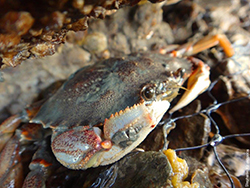
“It was so thick, nobody could see each other, but all the ships were blowing their horns,” recalls Doug George (’99, Oceanography). “There was this interesting cacophony of different pitches – the frigate’s big bellow, the oil barge with a deep rumble, and our higher-pitched Coral Sea, all communicating with one another. I’ve been on all of the earth’s oceans, and I’ve never seen anything like that again.”
Sharing George’s fond memories of HSU and passion for the sea is Marilyn Latta (’95, Marine Biology), and their commonalities helped them partner to address a prominent concern. Latta, a project manager for the State Coastal Conservancy, and George, an oceanographer with Applied Marine Sciences, Inc.¬, combined their specific expertise to address the effects of rising sea level and its influence on marine life and shoreline erosion.
“It’s nice to be working with an HSU alum. I get where (Latta) is coming from,” George said. “We rely on understanding each other’s background of trying to do good things for the planet, given realities of budget constraints and other things that get in the way of idealism.”
What’s good for the part of the planet called San Francisco Bay, Latta and George believe, is the use of natural materials to create a natural buffer that will protect the shoreline from erosion and offer habitat for estuarine species. That sustainability approach— known as “Living Shorelines”— has already been successfully employed in bodies of water along the Atlantic and Gulf coasts, but had not yet been tested in San Francisco Bay.

“Many of my colleagues weren’t familiar with the term, ‘Living Shorelines,’” said Latta . “There hasn’t been a lot of the combined biological/physical approach here, but we have erosion issues in San Francisco Bay that will only get worse with climate change. It’s pushed us to think about how we can design habitat restoration that has dual objectives of also providing a natural physical approach to reduce wave energy.”
Latta’s role in developing and managing the Living Shorelines demonstration project, located on a 1-acre plot near San Rafael, has focused on what might be called creature comforts. More than 17 local, state, and federal partners are involved in the project led by the State Coastal Conservancy. After 3 years of work on fundraising, design, and permitting, oyster and eelgrass reefs were constructed in July 2012, with the goal of encouraging the growth of these foundational species that act as ecosystem engineers and provide foraging and nesting habitats for invertebrates, fish, and birds.

George and his colleagues, meanwhile, looked at the down-and-dirty aspect. In theory, the same eelgrass and oyster reefs would reduce wave energy and relocate sediment inside the reefs that circulates through the bay. The process would stabilize shorelines at risk from erosion – something that could rapidly accelerate due to climate change.
Two years later, the preliminary evidence is in.
“Within three months, we saw oyster recruitment,” Latta said. “After about a year, we estimated about 2 million native Olympia oysters had settled in. We’re now observing other species, like Dungeness crab, gobies, and lots of other fish using the reef. There’s sturgeon, salmon, shrimp, invertebrates, clams, snails—overall an increase of 10 taxa at the site.”
Changes in the sediment transport processes are also evident, though George points out the effects will be better measured over a longer period of time. Still, early assessments show decreased wave energy and increased sediment retention.
“We put out instruments to see how wave energy is changing, and the data is definitely showing a reduction,” George said. “The wave heights were slightly reduced, and the general current pattern shifted just a little in some of the more protected areas.”
More immediate outcomes are the accumulation of sediment within the barrier’s boundaries and indication of the reef’s endurance.
“There has definitely been a significant amount of sediment built up inside the reefs,” George said. “In some places we’ve observed a build-up of 16-20 centimeters of sticky, mushy mud.
“Another important piece is how much these reefs sank into the mud. They were designed so they wouldn’t just sink unimpeded. We tracked the vertical movement and saw several inches of change within the first 4-5 months, but then it essentially stopped. That demonstrates another reason the design is successful.”
Both scientists’ understanding of the Living Shorelines concept and other healthy-earth ideas began during their years in Arcata. Both Latta and George look back at their Humboldt State education as a formative time that has greatly influenced their current work.
“At the time, there was a major project going on that was looking at the Eel River and sediment along the coastline off Humboldt Bay,” George said. “It was a cool experience to be involved as a student with real life research in a field that I didn’t know much about. Right from the start of my freshman semester, I was already connected to researchers from around the country.”
“My education at HSU was very much hands-on,” Latta said. “One example is my involvement with the campus recycling program. I learned about waste, and its impact worldwide. I came away with the realization that we can do things to change that, and most people are interested to get involved and help out.”
Latta’s and George’s research may come full circle, as the Living Shorelines application is being explored as an option to protect the Arcata marsh and waste treatment facility from being compromised by tidal action and rising sea level. The CSCC awarded an $86,000 grant to the city, a portion of which is currently funding a feasibility study that includes exploring a variety of design concepts.
“There are different ways to approach the Living Shorelines design concept,” said Su Corbaley, Latta’s coworker at the CSCC and the manager for Humboldt County-based projects. “You can’t cookie cutter it. It may or may not involve oysters and eelgrass, or it may involve extending the salt marsh plane by using clean fill from the Harbor District bay dredging.”